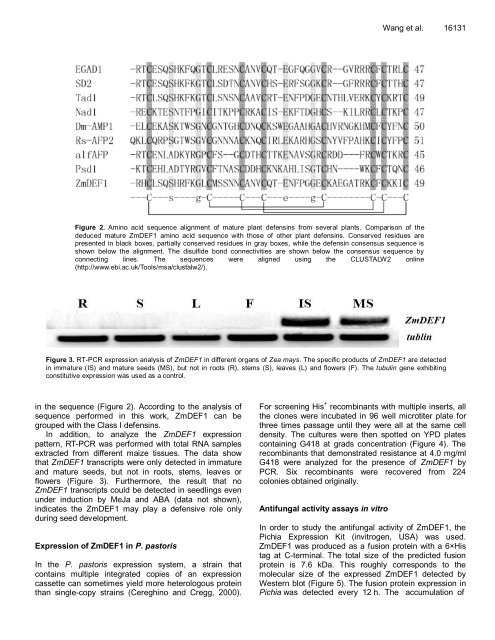(L.) C. Jeffrey from India using internal transcribed - Academic ...
(L.) C. Jeffrey from India using internal transcribed - Academic ...
(L.) C. Jeffrey from India using internal transcribed - Academic ...
You also want an ePaper? Increase the reach of your titles
YUMPU automatically turns print PDFs into web optimized ePapers that Google loves.
Wang et al. 16131<br />
Figure 2. Amino acid sequence alignment of mature plant defensins <strong>from</strong> several plants. Comparison of the<br />
deduced mature ZmDEF1 amino acid sequence with those of other plant defensins. Conserved residues are<br />
presented in black boxes, partially conserved residues in gray boxes, while the defensin consensus sequence is<br />
shown below the alignment. The disulfide bond connectivities are shown below the consensus sequence by<br />
connecting lines. The sequences were aligned <strong>using</strong> the CLUSTALW2 online<br />
(http://www.ebi.ac.uk/Tools/msa/clustalw2/).<br />
Figure 3. RT-PCR expression analysis of ZmDEF1 in different organs of Zea mays. The specific products of ZmDEF1 are detected<br />
in immature (IS) and mature seeds (MS), but not in roots (R), stems (S), leaves (L) and flowers (F). The tubulin gene exhibiting<br />
constitutive expression was used as a control.<br />
in the sequence (Figure 2). According to the analysis of<br />
sequence performed in this work, ZmDEF1 can be<br />
grouped with the Class I defensins.<br />
In addition, to analyze the ZmDEF1 expression<br />
pattern, RT-PCR was performed with total RNA samples<br />
extracted <strong>from</strong> different maize tissues. The data show<br />
that ZmDEF1 transcripts were only detected in immature<br />
and mature seeds, but not in roots, stems, leaves or<br />
flowers (Figure 3). Furthermore, the result that no<br />
ZmDEF1 transcripts could be detected in seedlings even<br />
under induction by MeJa and ABA (data not shown),<br />
indicates the ZmDEF1 may play a defensive role only<br />
during seed development.<br />
Expression of ZmDEF1 in P. pastoris<br />
In the P. pastoris expression system, a strain that<br />
contains multiple integrated copies of an expression<br />
cassette can sometimes yield more heterologous protein<br />
than single-copy strains (Cereghino and Cregg, 2000).<br />
For screening His + recombinants with multiple inserts, all<br />
the clones were incubated in 96 well microtiter plate for<br />
three times passage until they were all at the same cell<br />
density. The cultures were then spotted on YPD plates<br />
containing G418 at grads concentration (Figure 4). The<br />
recombinants that demonstrated resistance at 4.0 mg/ml<br />
G418 were analyzed for the presence of ZmDEF1 by<br />
PCR. Six recombinants were recovered <strong>from</strong> 224<br />
colonies obtained originally.<br />
Antifungal activity assays in vitro<br />
In order to study the antifungal activity of ZmDEF1, the<br />
Pichia Expression Kit (invitrogen, USA) was used.<br />
ZmDEF1 was produced as a fusion protein with a 6×His<br />
tag at C-terminal. The total size of the predicted fusion<br />
protein is 7.6 kDa. This roughly corresponds to the<br />
molecular size of the expressed ZmDEF1 detected by<br />
Western blot (Figure 5). The fusion protein expression in<br />
Pichia was detected every 12 h. The accumulation of

















